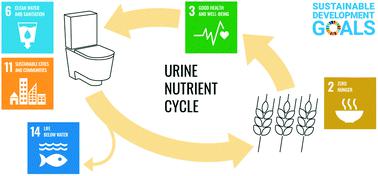当前位置:
X-MOL 学术
›
Environ. Sci.: Water Res. Technol.
›
论文详情
Our official English website, www.x-mol.net, welcomes your
feedback! (Note: you will need to create a separate account there.)
The potential contribution of urine source separation to the SDG agenda – a review of the progress so far and future development options
Environmental Science: Water Research & Technology ( IF 3.5 ) Pub Date : 2021-5-6 , DOI: 10.1039/d0ew01064b Tove A. Larsen 1 , Harald Gruendl 2 , Christian Binz 1, 3
Environmental Science: Water Research & Technology ( IF 3.5 ) Pub Date : 2021-5-6 , DOI: 10.1039/d0ew01064b Tove A. Larsen 1 , Harald Gruendl 2 , Christian Binz 1, 3
Affiliation

|
Sanitation and wastewater management are highly relevant for reaching a number of interconnected sustainable development goals (SDGs), especially SDG 6, the provision of safe drinking water and adequate sanitation for all as well as protection of water resources against pollution, and SDG 14.1, reducing nutrient emissions to the marine environment. Recent evidence increasingly shows that conventional sewer-based wastewater management will not be able to reach these targets. Rather than further optimizing and diffusing this ageing infrastructure paradigm, radical innovations like urine source separation technologies could help to leapfrog towards faster achievement of the SDGs. The technology would simplify on-site sanitation and develop a closed-loop nutrient cycle, thereby allowing for exceptionally high nutrient removal from wastewater and direct reuse in agriculture from the first day of implementation. Radical innovations, however, need decades to materialize. Based on a review of relevant academic and grey literature, we show how the past three decades of development of urine source separation have brought breakthroughs in toilet design and treatment processes, enabling the technology's value chain to reach the brink of maturity. In a short outlook, we discuss how the technology may reach global diffusion over the next decade, with the main remaining challenges relating to the creation of mass-markets for urine-diverting toilets, automation and mass-production of treatment systems, and the legitimation of fertilizer produced from urine in the agricultural sector.
中文翻译:

尿源分离对可持续发展目标议程的潜在贡献–回顾迄今为止的进展和未来的发展选择
卫生和废水管理与实现许多相互关联的可持续发展目标(SDG)高度相关,尤其是SDG 6,为所有人提供安全的饮用水和适当的卫生设施以及保护水资源免受污染,以及SDG 14.1,营养物质向海洋环境的排放。最近的证据越来越多地表明,基于下水道的常规废水管理将无法实现这些目标。与其进一步优化和推广这种老化的基础设施范式,不如尿源分离技术这样的根本性创新可以帮助实现更快实现可持续发展目标。该技术将简化现场卫生条件,并形成一个封闭的养分循环,因此,从实施的第一天起,就可以从废水中去除极高的养分,并直接在农业中再利用。但是,激进的创新需要数十年的时间才能实现。在对相关学术和灰色文献进行回顾的基础上,我们展示了尿源分离在过去的三十年中的发展如何在厕所设计和处理过程中带来了突破,使该技术的价值链达到了成熟的边缘。在短期内,我们将讨论该技术如何在未来十年内实现全球推广,主要挑战还涉及建立尿液分体式马桶的大众市场,处理系统的自动化和批量生产以及合法性。农业部门从尿中产生的化肥。
更新日期:2021-05-13
中文翻译:

尿源分离对可持续发展目标议程的潜在贡献–回顾迄今为止的进展和未来的发展选择
卫生和废水管理与实现许多相互关联的可持续发展目标(SDG)高度相关,尤其是SDG 6,为所有人提供安全的饮用水和适当的卫生设施以及保护水资源免受污染,以及SDG 14.1,营养物质向海洋环境的排放。最近的证据越来越多地表明,基于下水道的常规废水管理将无法实现这些目标。与其进一步优化和推广这种老化的基础设施范式,不如尿源分离技术这样的根本性创新可以帮助实现更快实现可持续发展目标。该技术将简化现场卫生条件,并形成一个封闭的养分循环,因此,从实施的第一天起,就可以从废水中去除极高的养分,并直接在农业中再利用。但是,激进的创新需要数十年的时间才能实现。在对相关学术和灰色文献进行回顾的基础上,我们展示了尿源分离在过去的三十年中的发展如何在厕所设计和处理过程中带来了突破,使该技术的价值链达到了成熟的边缘。在短期内,我们将讨论该技术如何在未来十年内实现全球推广,主要挑战还涉及建立尿液分体式马桶的大众市场,处理系统的自动化和批量生产以及合法性。农业部门从尿中产生的化肥。











































 京公网安备 11010802027423号
京公网安备 11010802027423号